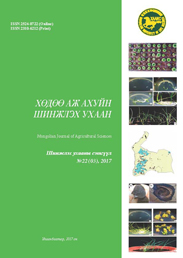Results of pasture monitoring research
DOI:
https://doi.org/10.5564/mjas.v22i03.941Keywords:
Grazing capacity, yield, climate impact,Abstract
Rangeland deterioration and restoration management has been one of the prominent issues. The present study focuses on the composition, cover, and yields accumulation of rangeland plant species from different ecological zones and subzones. Pasture yield in Mongolia varies in ecological zones and subzones (p≥0.001), so 39 sheep, during the summer, comfortably graze in one-hectare area in high mountain zone, - 72 in forest steppe, 21 in steppe and 13 in arid steppe area respectively. Whereas types and cover of plant species in high mountain rangelands are more than other areas, yield accumulation is most in forest steppe. The impact of climate change has dramatically increased recent years, considerably affecting on pasture plant cover and yield. During a dry season or period of drought, amount of yield reduces 40% in high mountain zone; 49% in forest steppe, 52% in semi-arid steppe and 55% in arid steppe. Since rangeland productivity varies due to the nature and climate in the ecological zones and subzones, pasture shall be utilized under appropriate policy that regulates this depending on its capacity, resource and natural and climate feature of area.Downloads
1638
Downloads
Published
How to Cite
Issue
Section
License
Copyright on any research article in the Mongolian Journal of Agricultural Sciences is retained by the author(s).
The authors grant the Mongolian Journal of Agricultural Sciences a license to publish the article and identify itself as the original publisher.

Articles in the Mongolian Journal of Agricultural Sciences are Open Access articles published under a Creative Commons Attribution 4.0 International License CC BY.
This license permits use, distribution and reproduction in any medium, provided the original work is properly cited.




